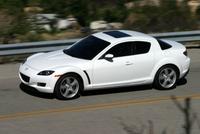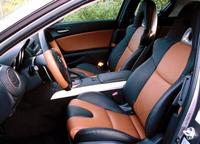2005 Mazda RX-8 Review
DRIVING DOWN THE ROAD
WITH CAREY RUSS
2005 Mazda RX-8
SEE ALSO: New Car Buyer's Guide for Mazda
If you're looking for something different in a car, consider the Mazda RX-8. While its radically distinctive styling is unlike that of anything else on the road today, that's not what really makes the RX-8 different. The real difference - hinted at outside, and none too subtly if you know what you're looking at - is under the hood. Where every other internal combustion-powered car on the road today has a reciprocating-piston engine, the RX-8 has a rotary-piston Wankel.
Mazda didn't invent the Wankel engine - it was the life work of Felix Wankel, a German inventor. Although Wankel had the idea for his engine in the 1920s, with the first patent granted in 1936, it wasn't until the 1950s that working engines were first built. With no reciprocating parts, the Wankel rotary-piston engine was remarkably smooth in operation. And it could develop much more power for a given displacement than a regular reciprocating engine, in a far smaller physical package. Forty-five years ago, nearly all automobile manufacturers, and even aircraft engine makers, had licenses to develop Wankel's engine. It was touted as ``tomorrow's power.''
Mazda was the only automaker to succeed with mass production of Wankel engines. For the early Wankel did have some drawbacks. Rotor seals, the equivalent of piston rings in a normal engine, originally had a short life span. Low emissions and fuel consumption were not design goals in the `50s and `60, but became necessities later. Despite their power potential, early Wankels had serious unburned hydrocarbon emissions and poor fuel economy. The emissions regulations and oil crises of the Seventies put an end to most manufacturers' Wankel development.
Mazda's engineers solved those problems, and three generations of RX-7 sports car put rotary performance solidly on the motoring map. By the time the third-generation RX-7 debuted in 1993, it had evolved from medium-performance, high-value fun to an ultra-light, finely-honed, take-no-prisoners sports car with a 255-horsepower twin-turbo engine in a 2800-lb chassis and a high price tag. Sales plummeted, and increasingly stringent emissions regulations seemed to mean the end of the Mazda Wankel.
Seemed to. The RX-7 soldiered on in Japan for a while. And then, in 1999 the ``RX-Evolv'' concept car was shown at the Tokyo Motor Show. It was a distinctive-looking, very angular sports coupe with a difference - it was a 2+2 featuring four doors, with the rear doors rear-hinged and front-opening in the manner of those found on the sides of pickup cabs. And under the hood was a Wankel. Would this mean a new RX-7?
It was too different to be the fourth-generation RX-7. But, with few changes, it did become the RX-8 when it made its American debut last model year. With real room for four and a much lower price point than the last RX-7, the RX-8 is aimed at a much broader clientele than the 7, but it's still a real sports car. The new twin-rotor engine develops 238 horsepower in the manual transmission model, without turbocharging, or 197 hp with an automatic. Second-year changes are minor, limited to a new ``Whitewater Pearl'' color choice and available Sirius(r) satellite radio.
I've just finished a week with a manual-shift RX-8 and found it to have a fine, and most unusual, combination of sports car performance and looks and compact sedan space. It is a unique machine, and Mazda is to be commended for developing the rotary-piston engine that is the RX-8's heart and soul.
APPEARANCE: There is nothing else on the road like the the RX-8. Many different shapes comprise its multi-mass styling, but the overall result is cohesive. The front, with its separate fenders and protruding interpretation of the Mazda pentagonal grille, evokes images of the last of the front-engined sports-racing cars of the early 1960s, but taken as a whole, the design is ultra-contemporary. In profile, it exhibits a classic wedge shape, with a low hood and high trunk lid. Unlike a regular sports coupe, the passenger cabin is a major element of the RX-8's look, and it is almost limo-formal, with plenty of height over the rear seat. With the base of the windshield at the rear of the front wheels, and the base of the backlight near to the rear of the car, it's difficult to tell whether the car is front- or mid-engined. Such are the advantages of the Wankel's small size - it's in front, but placed toward the center of the car. The triangular Wankel rotor shape makes itself known in the hood, and both front and rear lower bumper fascias.
COMFORT: The RX-8 departs far from the sports coupe norm in passenger accommodation. The genre is notorious for rear seats that are better-suited to suitcases than humans over the age of 10. The RX-8 is different. With no central ``B'' pillar, access is easy for all four passengers. If four six-footers aren't quite in the design spec, a five-eight person can fit comfortably behind a six-foot front passenger. All four seats are comfortably-padded and bolstered for support in spirited driving - and check out the Wankel-rotor shaped inserts in the front headrests. A rear-facing child seat can be installed in the rear. Make no mistake, the RX-8 is a driver's car, with very good instrumentation and near-perfect positioning of the controls. For convenience, both front and rear passengers have small storage boxes and cupholders in the center console, and there is a passthrough to the trunk. Trunk space is almost at a compact sedan size. The RX-8 is as useful around town as it is fun to drive on the open road, and can easily be an only car, not just a weekend toy.
SAFETY: Active safety equipment includes four-wheel vented antilock disc brakes and available dynamic stability control. Passive safety features include front, front side, and side curtain airbags, a front crumple zone, and anti-whiplash seats. The RX-8 was the only car of 68 tested by NHTSA to receive a five-star rating in a rollover test.
RIDE AND HANDLING: The Wankel engine's small size and light weight allow it to be placed low far back in the chassis, in what Mazda calls ``an advanced front-midship'' layout. This, and a fuel tank ahead of the rear axle, centralize the car's mass and for perfectly-balanced 50/50 weight distribution. Despite the large door openings, the chassis is much more rigid than that of the last RX-7, providing a solid mount for the aluminum-intensive fully-independent double wishbone front, multilink rear suspension. Even with the stock suspension calibration, as on my test car, there is no doubt that an RX-8 is a sports car. At everyday speeds, relatively soft spring rates give good ride comfort, although damping is a bit firm. Push harder, and the RX-8 gets happier. When the suspension is worked hard, it works it best, and with its wide, sticky ultra-low profile tires and excellent electrically-assisted rack and pinion steering, the RX-8 gets down the road in the manner of a classic sports car - even with three passengers. A firmer sports suspension is available for the performance-oriented.
PERFORMANCE: Hummmmmmmm. Ah, the unique sound of the rotary-piston engine. The RX-8's 1.3-liter 13B twin-rotor example goes from a tenor hum at lower speeds to a frenetic shriek (suitably muted for civilized operation, of course) at the 9,000-rpm redline. While power is adequate down low, the engine is best kept above 4,000 rpm for optimum performance. This is not a problem with the short-throw six-speed gearbox that is standard fare. Power builds in a linear manner, with a moderate top-end rush, and because there are no reciprocating engine parts, the engine is exceptionally smooth. And power there is, with 238 horsepower at 8500 rpm and 159 lb-ft of torque at 5500 rpm - from 80 naturally aspirated cubic inches, mind you. No turbo necessary. The four-speed automatic transmission model features a retuned engine, with more torque - 164 lb-ft at 5000 rpm - and less power, 197 hp at 7200 rpm, to work better with the automatic.
CONCLUSIONS: Mazda keeps the Wankel faith with the RX-8.
SPECIFICATIONS
2005 Mazda RX-8
Base Price $ 26,875
Price As Tested $ 31.685
Engine Type 2-rotor Wankel rotary-piston
Engine Size 1.3 liters / 80 cu. in.
Horsepower 238 @ 8500 rpm
Torque (lb-ft) 159 @ 5500 rpm
Transmission 6-speed manual
Wheelbase / Length 106.6 in. / 174.3 in.
Curb Weight 3029 lbs.
Pounds Per Horsepower 12.7
Fuel Capacity 15.9 gal.
Fuel Requirement 91 octane unleaded premium gasoline
Tires P225/45 WR18 Dunlop SP Sport 8096m
Brakes, front/rear vented disc / vented disc,
antilock standard
Suspension, front/rear independent double wishbone /
independent multilink
Drivetrain front engine, rear-wheel drive
PERFORMANCE
EPA Fuel Economy - miles per gallon
city / highway / observed 18 / 24 / 20
0 to 60 mph 6.0 sec
OPTIONS AND CHARGES
Grand Touring package - includes:
Bose(tm) audio, leather-trimmed seats, 8-way power
driver's seat with lumbar support, heated front seats,
Homelink, day/night mirrors, tilt & slide moonroof,
heated mirrors, xenon headlamps, foglamps,
DSC stability control $ 4,250
Delivery charge $ 560




